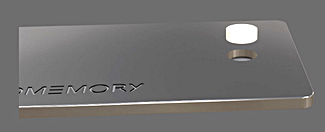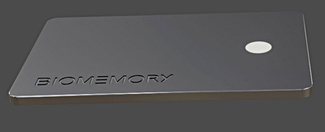French startup Biomemory says it can store 1 kilobyte in DNA for €1,000, making it one of the most expensive ways of storing digital data.
You don’t get a lot for the money as its I/O rate is very slow – it’s measured in days – since the card has to be transported to a lab for its DNA-stored contents to be sequenced.
Biomemory CEO Erfane Arwani said in a statement: “The launch of our DNA Cards represents a significant milestone in the evolution of data storage technology. After years of talk about the potential of molecular computing, we are incredibly proud to bring the first DNA data storage product to market that not only pushes the boundaries of innovation but also aligns with our commitment to environmental sustainability and efficiency.”


The card hosts a tiny metal capsule that holds the dried manipulated DNA strands of E. coli bacteria inside. These store that 1 KB of data, encoded into the ACGT (adenine, cytosine, guanine, thymine) sequences of their DNA nucleobases. The coding density is 1 bit per 4 nucleobases, we’re told.
A DNA Translate section of Biomemory’s product website lets you type in some text and see the resulting DNA nucleobase codes for it.

DNA Card customers supply the information they want storing as DNA. It’s sent by Biomemory to the Eurofins Genomics lab institution in Ebersberg, Germany. It produces the required DNA and dries it, then it’s placed into an air-tight capsule that is pressed into place in a card. This is done twice and the two cards are sent to the customer. Each card’s contents should last for at least 150 years.
Eurofins Genomics also provides the service through which DNA Card owners can access the information stored on their cards. They send in the cards to Eurofins, which sequences the extracted DNA from the capsule and sends the 4-base sequences back to the customer. It’s a destructive read as the capsule is destroyed in this process. The customer should then be able to decode the 4-base DNA string using a Biomemory DNA Translation feature – a very lengthy procedure.

This is a great marketing gimmick for people with €1,000 to splash out on what is arguably a fairly bonkers method for storing and accessing 1 kilobyte of data. A piece of paper locked in a vault would be cheaper and faster to read.
But that’s not the point. The DNA Card is a visible indicator of the potential of DNA storage. Apparently it is so dense that a single gram of DNA can store 215 PB. The technology trick is getting the encoding (writing) and sequencing (reading) times down from days to hours to minutes, and the size and cost of the equipment needed down from multiple thousands of dollars and deep freezer-size to an affordable piece of rack-mountable gear.
Biomemory says it plans to develop a Biomemory Prime product, capable of storing 100 PB and being deployed in datacenters, with availability in 2026. Previously it has discussed robotic tape-library-type gear, with the cartridges containing pellets of DNA encoding vastly more data than tape cartridges.
By then we may have glass-based archives, from Cerabyte and Microsoft’s Project Silica, with similar endurance and also better capacity than tape. They could have faster I/O speed than Biomemory’s Prime technology as bouncing light rays off a glass slab is likely much faster than rehydrating and sequencing extracted and dried DNA from capsules.
Biomemory talks up its technology using the usual archive-friendly spiel of only needing low power, being green, and so forth, but the same is true for glass-based archive tech. At this stage, DNA storage has aspects of being a solution looking for a problem rather than a killer archive technology in development, in our opinion anyway.







